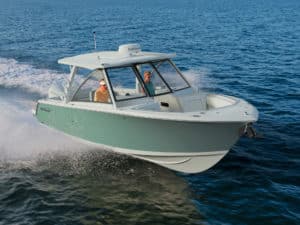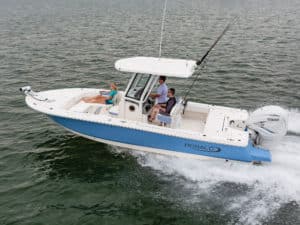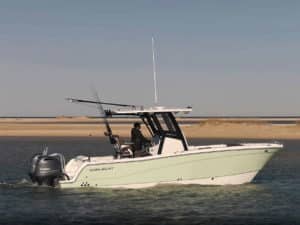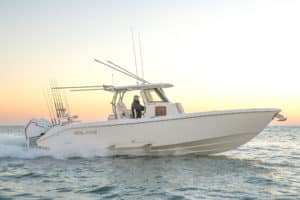Friday of a holiday weekend probably isn’t the best time to borrow a boat from a busy dealer. WorldCat’s representative, Anglers’ Marine in Fort Lauderdale, somehow made it happen amid delivering dozens of boats in time to take mothers all over town out for their special day.
Performance
I know that in rough water, a multihull provides a much smoother ride than a monohull. I also know that sometimes prospective buyers can’t get past the different feel of a cat, especially at slow speeds. Not a bad feel, just different. For example, at slow speed you feel the center of the tunnel hit the water with a minor thud that comes up through the floor.
Get the boat out into the 1- to 2-foot chop and this little WorldCat, made by World Class Catamarans, runs smooth as silk. This 23 represents the smallest model in the company’s line, but you wouldn’t know it from the performance.
Trolling at 7 mph produced moderate subsurface turbulence extending back to about the third wave. Other than that, you’ll find the wake clean.
Allowing zero bow rise, the twin Honda 150s lifted the 23 SF onto plane in two seconds, then hit a top speed of 45 mph at 6,000 rpm, burning 28.8 gph total. Cruising at 30 mph and turning 4,300 rpm used a scant 13.2 gph.
Compared with its longer siblings, the 23 can launch in a smaller sea. But it lands so softly that even my silver-haired guest, a former World War II U.S. Navy battleship sailor, had no problem with the extreme trials through which I run boats.
Drifting abeam of the close-together seas, the boat displayed the relatively short roll moment I expect from a multihull, combined with very gentle transitions, which make the ride eminently comfortable.
I turned the wheel hard over at 4,000 rpm with the engines trimmed up for cruising, and the 23 started to turn while remaining flat (rather than leaning into the turn like a monohull). However, it ultimately dipped its inside bow and turned very sharply while bleeding off speed. It managed a 180-degree corner in less than two boat lengths while keeping everyone safely in the boat.
Speaking of turns, I’d like to see a change in the location of the steering wheel and throttles. Spinning the wheel with your left hand while holding the throttles near idle with your right gives you a painful knuckle-busting. I think WorldCat should separate the wheel and controls by another few inches.
The only way to know that you’ve come up on the back side of a wave when running down-sea comes from the almost imperceptible hesitation. Otherwise, you get no swerving, slowing down or pounding. Though the WorldCat 23 won’t get up on plane on only one engine, it will easily get you back to shore at about 13 mph on one.
Fishing
WorldCat double-insulates every livewell and fish box with composite coring in the laminate itself and with urethane foam on the outside. The 23 has a molded space under the cockpit gunwale for your toes to move a tad farther outboard, keeping your center of gravity inboard for added safety.
Bottomfishermen should particularly appreciate the huge anchor locker in the bow with large storage box immediately aft. The 23 comes with two stainless cleats near centerline. I’d add two more on each bow for ultimate lateral maneuverability when anchored.
Each 23 comes with three standard rod holders under and two in each gunwale. However, order the optional hardtop and you get five more holders in a rocket launcher across its back.
I found the 35-gallon transom livewell more than adequate; it conveniently abuts a large athwartship, in-transom fish box as well.
Many people like to spin a cat using the gears since the engines enjoy such a wide separation. However, if you happen to have a hot fish alongside and need to spin quickly with the 23 WorldCat, I suggest you turn the wheel hard over and gun the engines. You’ll scribe a circle of less than a boat length instantly with absolutely no prop ventilation. In addition, unlike with most twin-outboard monohulls, you can readily back the WorldCat with complete control when fighting a fish. And though you probably won’t ever take water over the transom, this 23 boasts four very big cockpit scuppers. You can honestly fish this center console 360 degrees around the boat without having to walk around a single obstruction.
Design and Construction WorldCat wants to make passengers and anglers happy. Consequently, cockpit coaming pads on this WorldCat help anglers when fighting a fish, while a coaming pad around the forward seating acts as a comfy backrest for guests more intent on sunning themselves.
||| |—|—| | Specifications| | LOA| 24 ft.| | BEAM| 8 ft. 6 in.| | DRAFT| 1 ft.| | DEADRISE| n/a| | WEIGHT| 3,400 lb.| | FUEL| 150 gal.| | MAX HP| (2)150-hp OB| Despite its relatively small size, this 23 provides a dashboard expanse wide enough for two 10-inch electronics displays.
World Class Catamarans utilizes what it calls Unibody construction, a method of bonding the hull and deck with advanced methyl-methacrylate adhesives resulting in a solid, seamless hull. Each hand-laid hull consists of fiberglass and composite construction. This includes a transom built of fiberglass and high-density urethane composite with aluminum backing plates molded in to deal with the greater stresses incurred from higher horsepower and heavier weights of four-stroke outboard power.
The 316 stainless-steel hardware, all thru-bolted with aircraft-style Nylock nuts and fender washers or backing plates to spread the load, allows WorldCat to offer a lifetime warranty against structural corrosion and pitting to complement the 10-year limited, transferable structural hull warranty.








